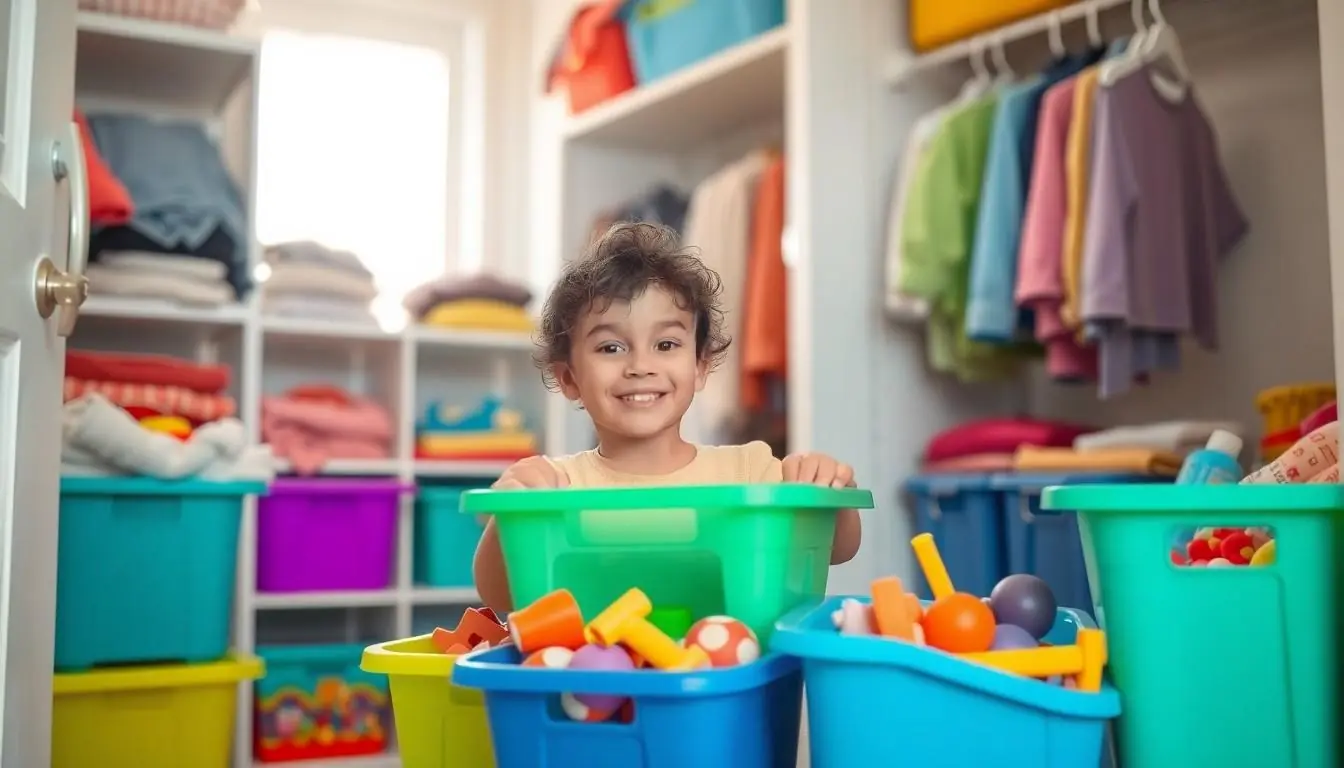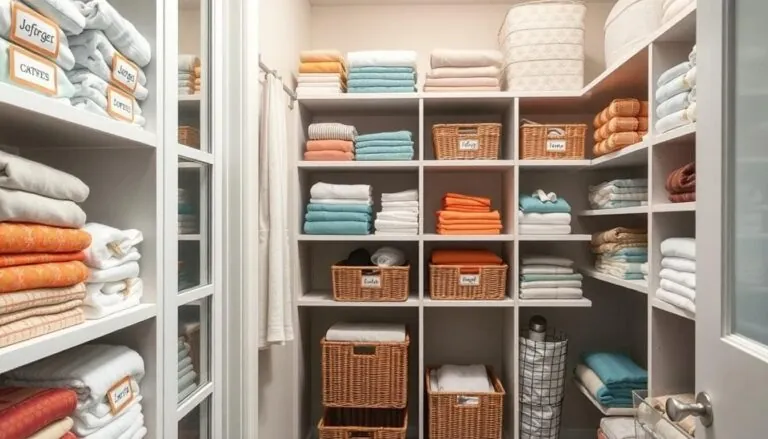Every parent knows the struggle of tackling a messy kids’ closet. It often resembles a tornado’s aftermath rather than a well-organized space. With toys, clothes, and shoes battling for dominance, finding that elusive pair of socks can feel like a treasure hunt gone wrong. But fear not! Transforming that chaotic closet into a tidy haven is easier than it sounds.
Table of Contents
ToggleImportance Of Closet Organization For Kids
Closet organization plays a crucial role in children’s development. A well-organized closet fosters independence, allowing kids to select their own outfits and manage their belongings. Simplified access to items helps them locate clothes, shoes, and toys easily, reducing frustration and time spent searching.
Enhancing organization skills benefits children academically. By learning to categorize and arrange, kids develop cognitive skills and improve their ability to focus and prioritize tasks. Structured environments translate into organized thoughts, promoting better study habits.
Safety concerns emerge in cluttered closets. Shoes or toys scattered on the floor can lead to tripping hazards. Organizing ensures that items remain stored securely, minimizing the risk of accidents.
Creating a visually appealing space adds to the motivation for kids to keep their closet tidy. Bright containers or fun labels entice children to engage in organizing their items. A personalized space encourages ownership of their belongings, instilling a sense of responsibility.
Involving children in the organizing process enhances their understanding of the value of maintaining an orderly space. Teaching them about sorting by type, color, or frequency of use cultivates lifelong habits. Parents can guide this learning process while allowing kids to make choices about how their closets look.
Organization directly impacts a child’s mood and behavior. A clear closet often leads to less stress and anxiety, creating a peaceful atmosphere. This calm environment supports better emotional regulation, allowing children to thrive both at home and in social settings.
Creative Kids Closet Organizing Ideas

Organizing a kid’s closet can transform clutter into a manageable space. Here are several creative ideas to streamline the process.
Use Color-Coded Bins
Color-coded bins make organizing fun and engaging. Assign specific colors for different categories, like toys, shoes, and seasonal clothes. Bright colors not only attract attention but also help children recognize where each item belongs. Utilizing bins with labels supports independence, allowing kids to identify contents easily. Choose sturdy options that can withstand wear and tear to support long-term use. This approach fosters a sense of ownership, encouraging kids to maintain their organized space.
Implement Hanging Organizers
Hanging organizers offer versatile storage solutions for various items. Utilize vertical space to maximize room efficiency; shelves often can’t accommodate smaller items. Look for organizers with pockets for accessories or folded clothes. Kids can easily access what they need, allowing for quicker outfit selections. Lightweight materials simplify installation and relocation when needed. Choosing clear pockets can make visibility easy, assisting kids in finding their belongings without frustration.
Invest In Adjustable Shelving
Adjustable shelving adapts as kids grow, accommodating changing storage needs. Start with lower shelves for easy access to frequently used items. As children mature, rearrange shelving to allow for bigger items or additional storage. Adding baskets or bins on these shelves creates defined areas for different belongings. This adjustable system promotes organization habits early on, making maintaining a tidy space simpler. Investing in durable shelving ensures longevity, supporting a child’s developing interests and collections.
Tips For Maintaining An Organized Closet
Maintaining an organized closet requires ongoing effort and effective strategies. Implementing regular practices helps ensure kids’ closets remain tidy and functional.
Regularly Declutter
Decluttering is vital for keeping closets organized. Set a schedule for decluttering, perhaps monthly, to review items. Evaluate clothing, toys, and accessories for relevance and condition. Donate any items no longer used or outgrown. The goal is to reduce clutter and maximize space. Focus on teaching kids the importance of letting go of unnecessary items. Create a designated area for storing donations temporarily. This approach not only alleviates chaos but also encourages children to make thoughtful decisions about their belongings.
Involve Kids In The Process
Involving kids in the organization process promotes responsibility and ownership. Encourage them to participate in sorting clothes and toys. Provide choices about what to keep and what to donate. Ask for their input on organizing methods that resonate with them. Use creative storage solutions they find appealing. Engaging children fosters a sense of pride in their space, improving their motivation to maintain organization. Celebrate their efforts to keep their closets tidy and recognize their progress regularly. This involvement builds lasting habits and reinforces the importance of a clean environment.
Seasonal Closet Organization Strategies
Organizing a child’s closet seasonally simplifies the task and promotes efficiency. Start by evaluating the current contents. Identify items that may no longer fit or be needed, which often vary with the seasons.
Parents can implement a seasonal rotation system. Keep winter clothes accessible during the colder months while storing summer clothes out of reach. This rotation maximizes space and keeps the closet tidy. Consider using clear storage bins for off-season clothing; this method avoids clutter and makes it easy to see what’s stored.
Encouraging kids to participate in seasonal changes enhances engagement. Allow children to sort through their clothing, teaching them to make decisions on what to keep or donate. Emphasizing this process fosters their independence and responsibility.
Setting aside time for a spring and fall clean can be beneficial. These seasonal check-ins help maintain organization. With proper guidance, children can assess their belongings, learn about decluttering, and understand the value of their possessions.
Color-coding the closet by season can also be effective. Assign colors to different seasons, making it easier for kids to choose appropriate outfits. This visual strategy transforms the organization process into a fun activity.
Using labels is another practical approach. Label storage bins with the season and item type to streamline the locating process. Labels cater to visual learners and simplify access for younger children.
Finally, consistency in seasonal organization reinforces lifelong habits. Regular organization maintains a tranquil environment, improving mood and behavior. Engaging children in this routine cements their understanding of order while establishing a clean, organized space for their belongings.
Organizing a child’s closet is more than just a chore; it’s an opportunity to instill valuable life skills. By creating a structured and engaging space, parents can help their children develop independence and responsibility. The strategies outlined not only simplify the organization process but also encourage kids to take pride in their belongings.
Regular maintenance and seasonal evaluations ensure that the closet remains functional and clutter-free. Involving children in these tasks fosters a sense of ownership and motivates them to keep their space tidy. Ultimately, a well-organized closet contributes to a calmer environment, positively impacting a child’s mood and behavior. Embracing these organizing ideas sets the foundation for lifelong habits that promote both personal growth and a harmonious living space.


